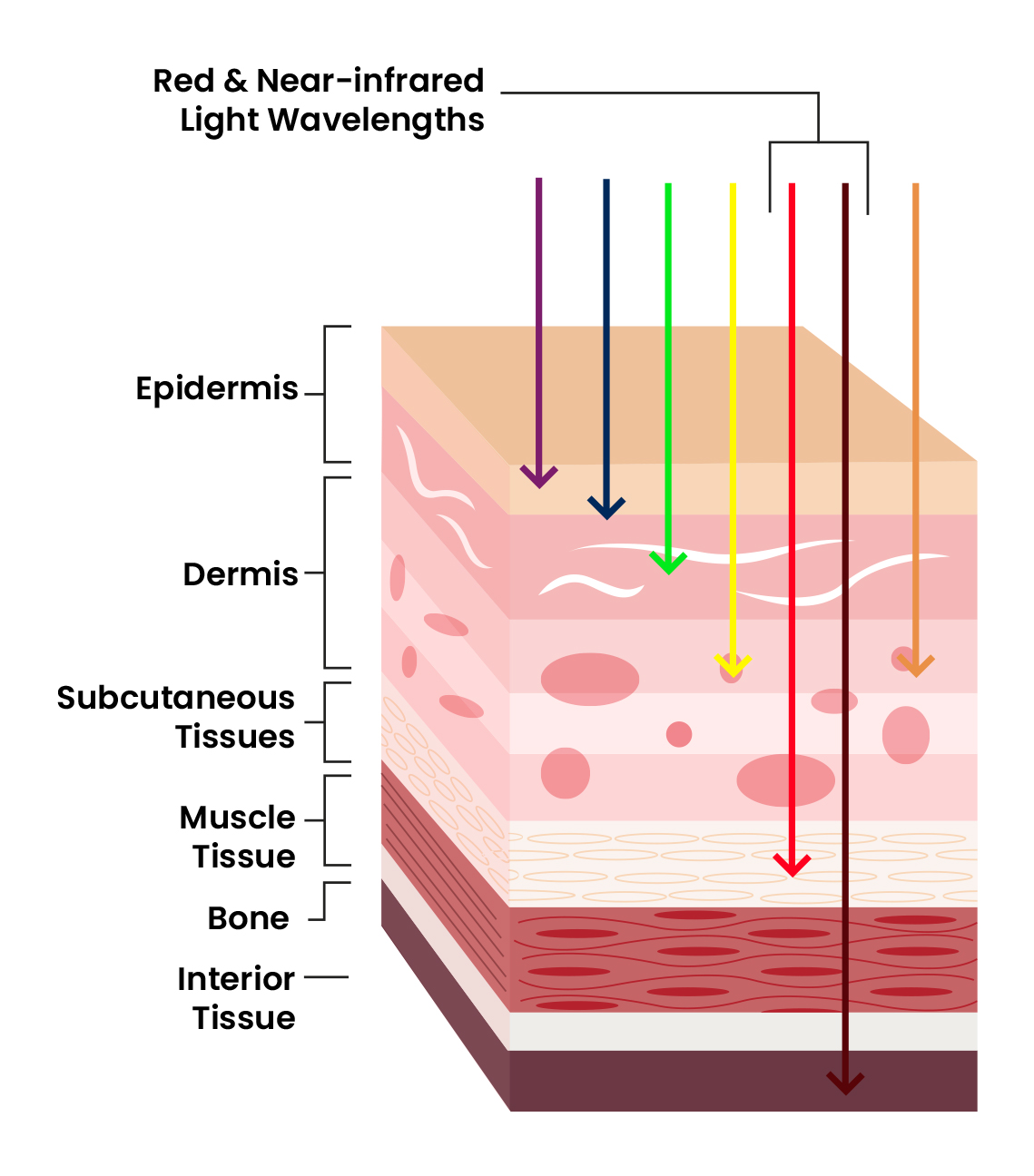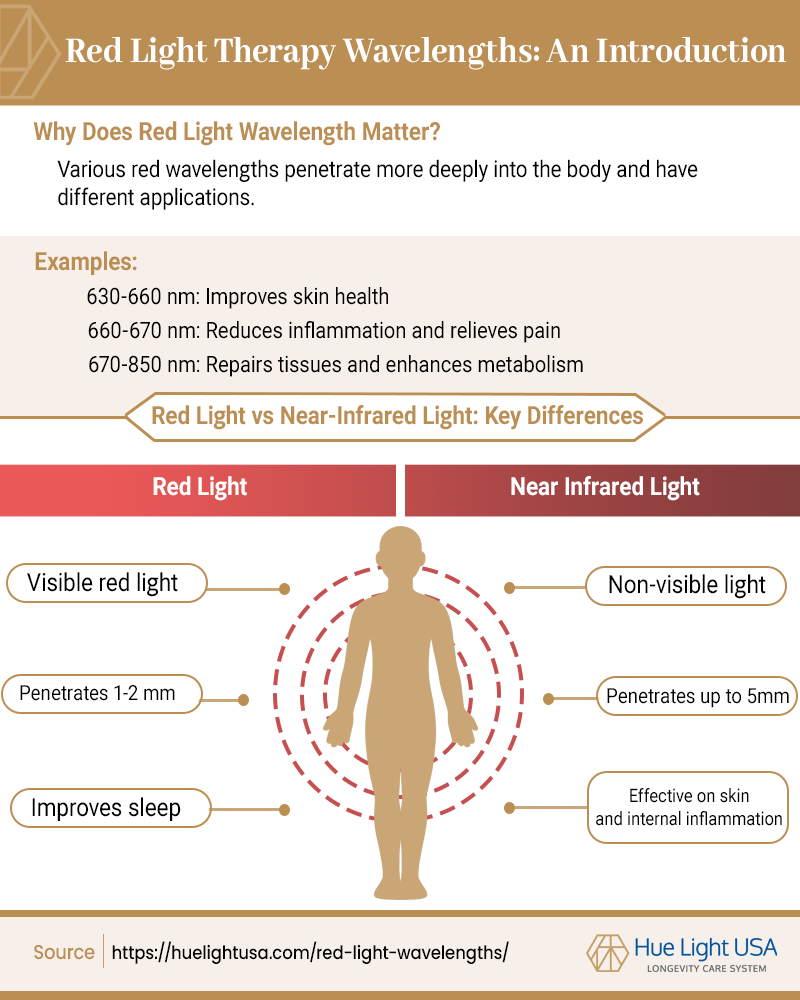If you’re new to red light therapy (RLT), you might be wondering:
Does any red light work? Or is there a specific red light wavelength I need to use?
The short answer is that, yes, wavelength matters for red light therapy. Most RLT devices provide light at specific wavelengths (and brightness levels), which you won’t receive from standard red bulbs.
Typically, RLT uses a variety of wavelengths. This includes the visible spectrum of red light (about 620-750nm). And the invisible near-infrared spectrum (about 780-1400nm).
Here’s why wavelength matters: Various red wavelengths offer different therapeutic benefits.
For example, 630nm (visible red light) may benefit skin conditions like psoriasis. And 810nm (a near-infrared wavelength) may offer neuroprotective properties and support mental health.
Therefore, the best wavelength for red light therapy depends on what you are treating. This guide offers a deeper look. Read on to discover which wavelengths to use, their benefits, and why combining red and near-infrared light may be the best solution.
Why Red Light Wavelength Matters
Not all red light is created equal! The key lies in the wavelength, which determines how light interacts with our tissues.
First, let’s look at wavelength. The visible light spectrum ranges from violet to red, with each color corresponding to a specific wavelength.
Red light sits at the longer end, with wavelengths between 620 and 700 nanometers (nm). Plus, there are invisible red wavelengths, as well, with the near-infrared spectrum (about 700-1400nm) used most in RLT.
There are numerous health benefits of RLT; however, they change with wavelength:
- 630-660 nm: This range penetrates shallowly, reaching the outermost layers of skin. These shorter red wavelengths stimulate collagen production, improve skin health and reduce wrinkles.
- 660-670 nm: This “sweet spot” wavelength penetrates deeper, reaching muscle and connective tissues. It’s often associated with pain relief and inflammation reduction.
- 670-850 nm: These near-infrared wavelengths (just beyond the visible spectrum) penetrate the deepest, reaching bones and joints. They’re linked to enhanced cell metabolism and tissue repair.

Choosing the best wavelength depends on your desired outcome. For superficial concerns like wrinkles, shorter wavelengths like 630nm might suffice. For deeper-seated issues like joint pain, venturing towards 660nm or even near-infrared might be more effective.
How Frequency Relates to Wavelength
The terms frequency and wavelength are often used interchangeably. However, there’s a key distinction between them.
Imagine a wave: its distance from peak to peak is the wavelength (measured in nanometers), and the number of peaks passing a point each second is the frequency (measured in Hertz).
In red light therapy, the higher the frequency, the shorter the wavelength, and vice versa. Red light has relatively long wavelengths, about 700nm. That means its waves oscillate at a lower frequency than blue light, for example.
Therefore, red light has a lower frequency (around 430 terahertz), compared to blue light’s frequency of 750 terahertz. Here’s a look at how frequency relates to wavelength:
- Longer wavelengths (lower frequency): Pack more energy per photon, allowing them to penetrate deeper into tissues like muscles and joints and may support treatment for mental health conditions. Think NIR light, the deep-tissue warrior.
- Shorter wavelengths (higher frequency): These wavelengths deposit their energy closer to the surface. This makes them perfect for skin-level targets like wound healing, psoriasis and anti-aging. Red light falls in this range.
Red Light vs Near Infrared Light Wavelengths: Key Differences

Now, let’s take a closer look at red light vs near-infrared light.
Red light therapy has gained traction for its potential to promote healing, reduce pain, and boost skin health. But many don’t realize that red light therapy often includes near-infrared (NIR) wavelengths.
Here’s a quick look at differences:
Red Light Wavelengths
Visible red light doesn’t penetrate the skin as deeply as NIR. In fact, it penetrates only about 1-2mm. Therefore, this type of red light is often used to treat the upper layers of the skin.
These wavelengths (620-700nm) are ideal for addressing surface-level concerns:
- Wound healing: RLT stimulates cell growth and collagen production, accelerating wound closure.
- Pain relief: RLT reduces inflammation and promotes tissue repair, alleviating pain in muscles, joints, and skin.
- Skin health: RLT boosts collagen production, improves elasticity, and reduces the appearance of wrinkles and fine lines.
Near-Infrared Wavelengths
NIR light plunges deep, reaching muscles, joints, and even bones up to 5-10mm. This makes NIR light therapy ideal for:
- Muscle recovery: NIR light enhances blood flow, improves oxygen delivery, and reduces muscle fatigue and soreness.
- Pain management: NIR light relieves chronic pain conditions like arthritis and neuropathic pain.
- Cellular rejuvenation: NIR light penetrates deeper tissues, potentially increasing energy production and overall cellular health.
Exploring the Benefits of Red Light Therapy Wavelengths (630-850nm)
In terms of light therapy research, red light has been the most widely studied. This is mainly because it was first discovered in the 1960s and has been used since. However, other types of light therapies (including blue and green) are now being researched more.
Generally, the research has explored the health benefits of various red wavelengths. Here’s a sample of some of the studies:
Red Light Wavelengths
- Stimulated hair growth (650nm): One study in vitro found that 650nm red light promoted hair growth.
- Improved bone healing (660nm and 880nm): This in vitro study found that NIR immediately increased ATP production (cellular energy) and callouses formed faster in fracture healing.
- Reduced neuropathic pain (660nm): A small study explored red light’s ability to treat neuropathic pain; researchers concluded the 660nm red light wavelength may improve nerve regeneration.
Near-Infrared Wavelengths
- Enhanced muscle performance (850nm): A small case-control study found that near-infrared therapy increased max exercise loads and reduced fatigue and creatine kinase (muscle damage).
- Support for brain disorders (808nm): A study cited in an extensive review of research found that 808nm light provided support following stroke in an animal model.
- Help with depression and anxiety (810nm): A 2009 study found a four-week treatment protocol with NIR light helped reduce depression and anxiety scores.
These are just a small sample of studies. There are numerous others that explore photobiomodulation and red light therapy.
Red Light Therapy Wavelengths: An Introduction

What’s the Best Wavelength for Red Light Therapy?
The truth is, there’s no single victor in the battle of red light vs. NIR wavelengths. They both offer unique benefits depending on your needs:
- Red light: For surface-level issues like skin health and wound healing.
- NIR light: For deeper tissue concerns like muscle recovery and chronic pain.
However, many red light therapy beds, for example, combine red and NIR wavelengths (and even sometimes green wavelengths). Therefore, sessions include a wide range of red wavelengths for synergistic effects.
Which wavelength is best for you? Consult with a physician or red light therapy provider for advice. But remember that consistency is key.
Regular sessions, regardless of wavelength, are crucial for maximizing red light therapy’s potential.
Wrapping Up
Wavelength is the biggest reason you should choose reputable red light devices. Advanced systems have measured and verified their wavelength outputs, and they provide users the ability to adapt and tune which wavelength of light is used.
Therefore, with an advanced system, you can experience a full range of red light, helping to maximize both the internal and surface-level benefits.
Hue Light USA distributes a variety of premium red light therapy devices, including a red light therapy mat, a breast PBM pad, and a state-of-the-art red light therapy bed.








